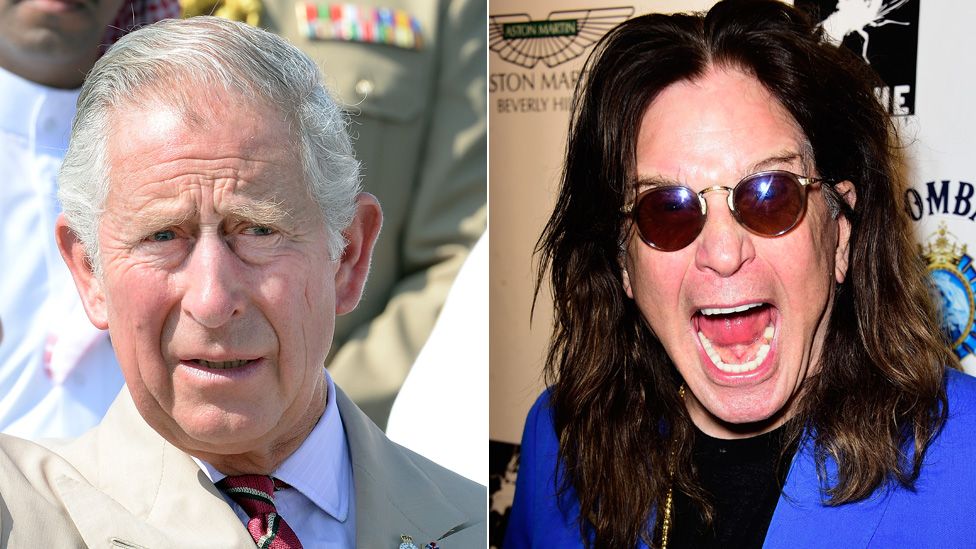What do Prince Charles and Ozzy Osbourne have in common?
- Published

Consider Prince Charles and Ozzy Osbourne, even in a darkened room it would be difficult to mistake one for the other but by some measures they are uncannily similar.
And for some analytic engines that decide which adverts you see online, the Prince of Wales and the Prince of Darkness are almost indistinguishable.
The two men were born in the same year, 1948, are wealthy, self-employed, and spend a lot of time in the same location, London.
They both like international travel, dogs, sports cars, fine wines, have children and have married and re-married.
But you probably wouldn't want to send the same ad to both of them.
So how can ad firms differentiate between seemingly similar people and fire more relevant ads at them?
"The best way we have found to do that is through the picture gallery," says Ofri Ben-Porat, founder and chief executive of Pixoneye, an Israeli ad tech firm. "Young people today take photos of everything."
And what we take photos of reveals more about us that almost anything else, he says. Our phones are becoming extensions of ourselves.
So Pixoneye is working with app makers on ways to use what it learns from analysing picture galleries to tailor adverts to particular lifestyles.
"You don't necessarily see fewer ads," says Mr Ben-Porat, "You'll see the same amount of adverts but there will be different creatives for different users."
In other words, the same ad campaign will need to have multiple versions to suit each audience. And this will put more pressure on advertisers and their agencies to produce more individualised content, he says.
In the early days of web advertising that list of similarities was useful, says Mr Ben-Porat, as it gave firms more data about potential customers than they ever had before.
That approach worked well when most people browsed the web via a desktop or laptop, but it looks crude now that people spend so much time using apps or going online via a phone or tablet, he argues.
"If you browse on a laptop you can see the same advert three times a day and live with it," he says.
"But think about how many times a day or hour people look at their mobile against how many times they open a laptop."
Waiting for the same ad to load again and again or simply seeing the same one many times a day will do little to aid the "engagement" that firms crave, he says.
"It would be better to find where in the data they differ and how you can pick up on those differences."
'Out of business'
It is not just the bigger firms that need to do better with adverts.
Smaller firms and lone app developers are keen to turn more clicks into customers, says Ted Nash, co-founder of app monetising platform, Tapdaq.
They have to, he says, because without those ad dollars and pounds they would go out of business, given that most apps are free to download.
"Only 1% of the apps in the stores are monetised through an app purchase," he says. "The other 99% are ad-funded."
The problem is that most consumers see mobile ads as, at best, a necessary evil and, at worst, intrusive annoyances to be thwarted with ad-blocking software.
Yet people need to realise what the revenue from ads makes possible, Mr Nash argues.
"It comes down to a fundamental exchange," he says. "Would they rather pay for everything or not?"
Tapdaq is working on a system that helps smaller developers do a better job of targeting ads rather than bombarding users with irritating and irrelevant ads that simply drain your mobile battery.
"Developers would absolutely love to have a full-time career building apps," he says, "but that has become more and more difficult, so they are becoming more desperate and adopting more aggressive ad strategies that increasingly annoy customers," he says.
Tapdaq's system gives developers more control over which ad networks are used within the app and what ad formats, helping them serve the right type of ad at the right time.
"This can make a huge difference to rates of engagement," he says.
A bad ad can net response rates as low as 7%, whereas a properly targeted ad can see five times as many people clicking on it, says Mr Nash.
"This is the money that pays them to live. They need the advertising; that's why they like it and are active around it."
Deep analysis
But despite the inability of some ad-serving systems to tell the difference between Chuck and Ozzy, David Gosen, of online ad firm Rocket Fuel, believes they are getting better.
"Marketing managers used to complain that they were wasting half of their advertising budget and, unfortunately, they didn't know which half," he says. "Now they are getting much closer to knowing which 50% is being wasted and how effective their spend is."
This is because they know so much more about what we search for online and what sites we visit.
Many of the ads we see are now chosen by real-time "programmatic" ad auctioning systems. Rocket Fuel's system works out the best moment for hitting us with a specific advert. So the ad will change depending on the time of day and the device we're using.
When they're done right, ads can help companies reach those customers who are really fans and motivate them to act.
"It's about the right combination of creative and message," he says. "If a company has data on loyal customers then it should be able to work with them to build engagement and turn them into brand advocates.
"It's loyalty you are starting to build."
- Published25 July 2016
- Published11 September 2015
- Published13 July 2016
- Published4 October 2016
- Published5 October 2016